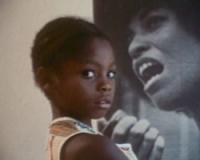During the L.A. Rebellion: Creating a New Black Cinema Symposium, panelist Ed Guerrero, professor of film and African American studies at New York University, discussed Black film then and now. He opened by addressing the controversial comparison of the films from the L.A. Rebellion to those of the Blaxploitation era. Using call and response, a form of communication between speaker and listener, Guerrero stated that both L.A. Rebellion and Blaxploitation filmmakers were engaged in this type of an exchange in response to the volatile world they lived in. He stated that though they had distinct differences, they both “come out of the same revolutionary impulses,” and both evoke the same images and strategies. He went on to explore how “visions of a liberated future” and the filmmakers best impulses guided them and, as a result, their films were a form of “social diagnosis” and their response, which was “look at what we can be.” Though not as much time was spent on the now, Guerrero did acknowledge the newest cultural phenomenon around filmmaking sure to affect our future. This phenomenon he calls the “Eternal Now” – the eternal electronic presence made possible by cell phone cameras, flip cams and other mobile devices as tools of production. With young people using YouTube to express themselves and with youth in countries like Japan and China using cell phone text messaging to write novels, creative expression is now in “everyone’s hands” according to Guerrero.
How will this easy access change the face of Black film? It certainly frees filmmakers from dependence on studio financing and Hollywood validation. The web series is becoming increasingly popular among African Americans and is often produced independently. One such popular series is “The Misadventures of Awkward Black Girl”. According to the Huffington Post, as of August of this year, the series creator Issa Rae raised more than $44,000 via Kickstarter, an online funding platform for creative projects, to produce more installments of the series. At the time, the series had an average of 60,000 viewers, and in less than 24 hours after launching the fundraising campaign, Rae raised her first $4,000 using Facebook and Twitter as additional channels to get the word out. Social networks and digital recording tools are certainly giving creative power to the masses, and are leading to simplified production and distribution. Like with L.A. Rebellion filmmakers, we have unique points of view to express, however, unlike L.A. Rebellions filmmakers, filmmakers today with digital tools are equipped to tell those stories to larger audiences without Hollywood in the way.
—Michelle Amor and Felischa Marye






 Mobile Navigation
Mobile Navigation

